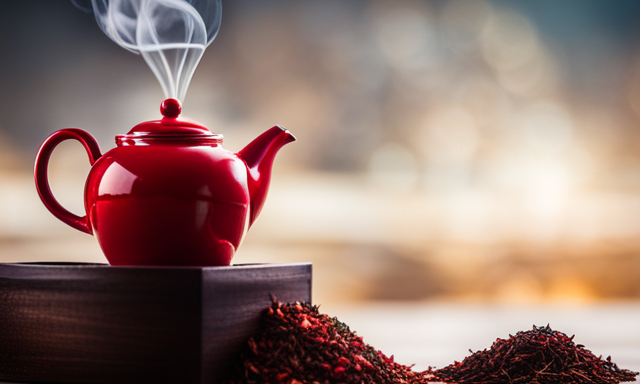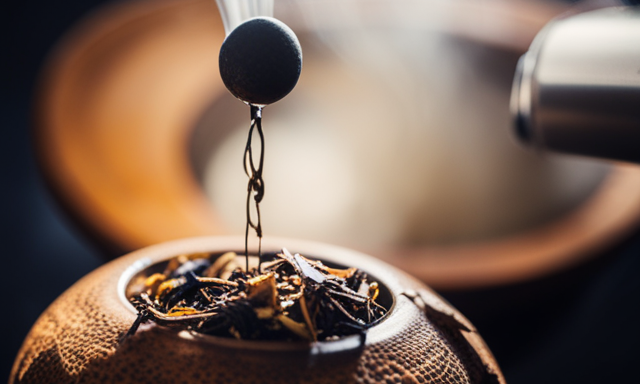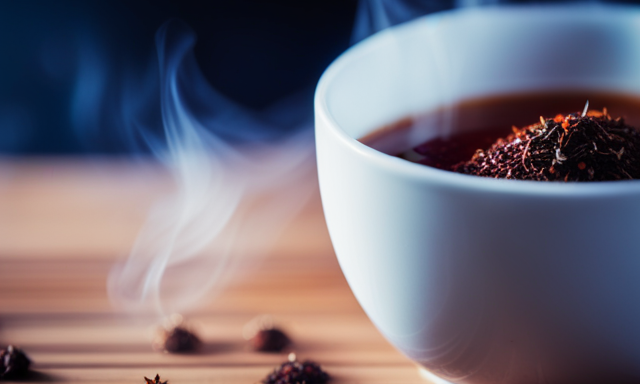Have you ever wondered how long to steep a cup of rooibos tea to get that perfect infusion? Well, wonder no more! In this article, I will guide you through the art of steeping rooibos tea, ensuring that every sip is a delightful experience.
Rooibos tea, also known as red bush tea, is a caffeine-free herbal beverage that originates from South Africa. It is cherished for its earthy flavor and numerous health benefits. But to truly unlock its full potential, you must pay attention to the steeping process.
By choosing the right leaves, preparing your equipment, and finding the ideal steeping time, you can create a cup of rooibos tea that is rich in flavor and aroma. So, grab your favorite teapot, sit back, and let me show you the secrets to steeping a perfect cup of rooibos tea.
Key Takeaways
- The optimal steeping time for rooibos tea is 5-7 minutes, but it can vary based on personal preference.
- Experiment with different steeping times to achieve the desired flavor profile, with shorter steeping times resulting in milder flavor and longer steeping times producing a stronger taste.
- Water temperature is important for enhancing the flavor of rooibos tea, with a recommended temperature of 200°F (93°C). However, you can experiment with different temperatures to find the one that best suits your taste.
- Straining the tea using a fine-mesh sieve is crucial for a clean and sediment-free drinking experience. It helps remove loose tea leaves and particles, ensuring a smooth cup of tea.
Understanding Rooibos Tea: An Introduction
To fully appreciate the warm, earthy flavors of rooibos tea, you should steep it for about five minutes, allowing the vibrant red color to infuse the water and transport you to the picturesque landscapes of South Africa.
Rooibos tea, also known as red bush tea, has a rich history that dates back centuries in the Western Cape region of South Africa. The indigenous Khoisan people were the first to recognize the potential of the rooibos plant and its numerous health benefits.
Today, rooibos tea is enjoyed worldwide for its refreshing taste and health-promoting properties. There are two main types of rooibos tea: green and traditional. Green rooibos is unfermented, which gives it a lighter, more delicate flavor, while traditional rooibos undergoes a fermentation process that enhances its robust taste.
Understanding the history and exploring the different varieties of rooibos tea allows you to fully embrace the unique qualities of this beloved beverage.
So, let’s now delve into the benefits of rooibos tea.
The Benefits of Rooibos Tea
Rooibos tea offers a plethora of health perks, making it a delightful addition to your daily routine. Its antioxidant properties help fight off free radicals and reduce the risk of chronic diseases such as cancer and heart disease. Additionally, rooibos tea contains high levels of vitamin C, which boosts the immune system and promotes healthy skin. The tea is also known for its ability to relieve stress and promote relaxation, thanks to its calming effects.
To better understand the health benefits of rooibos tea, take a look at the table below:
| Health Benefits | Description |
|---|---|
| Boosts Immune System | Rooibos tea is rich in vitamin C, aiding in the strengthening of the immune system. |
| Fights Inflammation | The tea’s anti-inflammatory properties help reduce inflammation in the body. |
| Supports Heart Health | Rooibos tea may improve heart health by reducing cholesterol levels. |
| Promotes Digestive Health | It helps with digestion and alleviates common digestive issues such as bloating and constipation. |
Now that you’re aware of the numerous health benefits, let’s delve into the next section to learn about choosing the right rooibos tea leaves.
Choosing the Right Rooibos Tea Leaves
When selecting the perfect rooibos leaves, consider factors such as aroma, color, and taste to ensure a satisfying brew.
Choosing between organic and non-organic rooibos tea leaves is a personal preference. Organic leaves are grown without the use of pesticides or synthetic fertilizers, making them a healthier option. On the other hand, non-organic leaves may have a slightly stronger flavor due to the use of chemicals during cultivation.
Another decision to make is between loose leaf and tea bags. Loose leaf tea allows for more control over the steeping process and often results in a richer and more flavorful cup of tea. Tea bags, on the other hand, offer convenience and are great for on-the-go brewing.
Now that you have chosen your rooibos leaves, let’s move on to preparing your tea equipment.
Preparing Your Tea Equipment
Preparing your tea equipment is an important step in ensuring a smooth tea experience. To start, it’s crucial to clean your teapot thoroughly. Residue from previous brews can affect the taste of your current cup, so give it a quick rinse with hot water.
When choosing a teapot, opt for one made of heat-resistant materials like glass or ceramic. These materials retain heat and flavors better. Additionally, make sure the teapot has a built-in infuser or use a separate tea infuser to strain the leaves.
Once your teapot is clean and ready, it’s time to move on to heating the water. Heating the water to the ideal temperature for steeping is essential for extracting the best flavor and aroma from your rooibos tea leaves.
Heating the Water to the Ideal Temperature
Get ready to elevate your tea experience by heating your water to the ideal temperature.
The ideal water temperature for steeping rooibos tea is 200°F (93°C). This temperature allows the flavors and aromas of the tea leaves to fully infuse into the water, resulting in a rich and flavorful cup of tea.
To achieve this ideal temperature, you can use a tea kettle with temperature control or a thermometer to monitor the water temperature. Once the water reaches the desired temperature, carefully pour it over the tea leaves in your infuser.
The heat of the water will begin to release the flavors of the rooibos tea, creating a soothing and aromatic brew. Now that the water is at the perfect temperature, it’s time to move on to the next step of adding the rooibos tea leaves to the infuser.
Adding the Rooibos Tea Leaves to the Infuser
Now it’s time to infuse your rooibos tea with the exquisite flavors of the leaves by adding them to your infuser. Steeping techniques are crucial to achieving the perfect cup of rooibos tea. The optimal infusion time can vary depending on personal preference, but generally, steeping rooibos tea for 5-7 minutes will yield a well-balanced flavor. However, if you prefer a stronger brew, you can extend the steeping time up to 10 minutes. To help you keep track of the steeping time, here’s a simple table:
| Steeping Time | Tea Strength |
|---|---|
| 3 minutes | Mild |
| 5 minutes | Medium |
| 7 minutes | Strong |
| 10 minutes | Very strong |
By following these steeping techniques, you’ll be able to enjoy a delightful cup of rooibos tea. Moving on to the subsequent section about ‘steeping time: finding the perfect balance,’ we will explore how to achieve the ideal infusion time for your personal taste.
Steeping Time: Finding the Perfect Balance
Discover the delicate dance between time and flavor as you seek the perfect balance in steeping your rooibos tea. Steeping time is crucial in unlocking the full potential of the tea leaves and finding the perfect brew. Here are three essential factors to consider in the art of steeping tea:
-
Patience: Allow the rooibos tea leaves to steep for at least 5 minutes to ensure a robust flavor profile. This extra time allows the natural oils and flavors to infuse into the water, creating a rich and satisfying cup.
-
Temperature: Maintain a water temperature of around 200°F (93°C) for optimal steeping. This temperature allows the tea leaves to release their flavors without becoming bitter or astringent.
-
Experimentation: Don’t be afraid to adjust the steeping time to suit your personal taste preferences. Some may prefer a shorter steeping time for a milder brew, while others may enjoy a longer infusion for a stronger flavor.
Finding the perfect balance in steeping your rooibos tea is an art that requires patience, temperature control, and a willingness to experiment. By carefully monitoring the flavor and aroma, you can ensure that each cup of rooibos tea is a delightful experience.
Monitoring the Flavor and Aroma
Immerse yourself in the sensory journey of monitoring the exquisite flavor and tantalizing aroma of your steeped rooibos brew.
As you steep your rooibos tea, it is crucial to monitor both the taste and color to achieve the perfect cup. The longer you steep, the stronger the flavor becomes, so it’s essential to find the right balance.
Start by tasting your tea after a few minutes of steeping and continue to monitor until it reaches your desired strength. If the flavor is too weak, simply extend the steeping time by a minute or two. Conversely, if it becomes too strong, reduce the steeping time accordingly.
Once you have achieved the perfect taste and color, it’s time to move on to the next step of straining and serving your cup of rooibos tea.
Straining and Serving Your Cup of Rooibos Tea
To strain and serve your exquisite brew of rooibos, simply pour the liquid through a fine-mesh sieve. This will allow the vibrant flavors to cascade into your waiting vessel, creating a sensory experience that will make your taste buds sing.
Straining techniques play a crucial role in achieving a smooth and sediment-free cup of rooibos tea. By using a fine-mesh sieve, you can easily remove any loose tea leaves or particles, ensuring a clean and enjoyable drinking experience.
Serving suggestions for rooibos tea are versatile and can be tailored to your personal preferences. Some enjoy it hot with a drizzle of honey, while others prefer it over ice with a splash of lemon. The possibilities are endless!
Now, let’s delve into the exciting world of experimenting with different steeping times and techniques to further enhance your rooibos tea experience.
Experimenting with Different Steeping Times and Techniques
Delving into the world of rooibos tea, I have discovered that one can truly enhance their experience by experimenting with various steeping times and techniques.
The optimal steeping time for rooibos tea is typically around 5-7 minutes, but this can vary depending on personal preference. Some people prefer a shorter steeping time for a milder flavor, while others enjoy a longer steep for a stronger and more robust taste.
Additionally, the temperature of the water can also affect the flavor profile of the tea. Using water that is around 200°F (93°C) is generally recommended for rooibos tea.
As for techniques, some people prefer to use a tea infuser or a teapot with a built-in strainer, while others prefer to simply steep the loose leaves in a cup and strain before serving.
Ultimately, the key is to experiment and find the steeping time and technique that suits your taste buds best.
Frequently Asked Questions
Can I use the same amount of rooibos tea leaves for every cup I steep?
Yes, you can reuse the same amount of rooibos tea leaves for every cup you steep. However, keep in mind that steeping time may vary depending on personal preference or the desired strength of the tea.
What is the difference between loose leaf rooibos tea and tea bags?
The difference between loose leaf rooibos tea and tea bags lies in their taste and brewing methods. Loose leaf tea offers a fuller flavor and requires a longer steeping time, while tea bags provide convenience and a milder taste.
Are there any health risks associated with drinking rooibos tea?
There are potential benefits to drinking rooibos tea, such as its antioxidant properties and potential to improve heart health. However, some potential side effects include liver damage and allergies.
Can I reuse rooibos tea leaves for a second steeping?
Yes, you can reuse rooibos tea leaves for a second steeping. This allows you to enjoy the benefits of a milder and more subtle flavor. It’s a great way to make the most out of your tea leaves.
What is the best way to store rooibos tea to maintain its freshness?
To maintain the freshness of rooibos tea and preserve its flavor, the best storage method is to keep it in an airtight container away from light, moisture, and strong odors. This ensures a longer shelf life and a more enjoyable cup of tea.
Conclusion
In conclusion, steeping a cup of rooibos tea is a delicate art that requires patience and precision. By understanding the unique flavors and benefits of rooibos tea, choosing high-quality leaves, and mastering the steeping process, you can create a truly exquisite cup of tea.
So, how long do you steep a cup of rooibos tea? The recommended steeping time for rooibos tea is typically around 5 to 7 minutes. However, some people prefer a stronger flavor and may opt for a longer steeping time of up to 10 minutes. Ultimately, it comes down to personal preference.
During the steeping process, it’s important to use water that has just reached its boiling point, around 212°F (100°C). This will help to extract the full flavor and benefits of the rooibos leaves.
Once the steeping time is up, simply strain the tea leaves and pour yourself a cup of the beautifully brewed rooibos tea. You can enjoy it as is or add a touch of honey or a slice of lemon to enhance the taste.
So why not indulge in the pleasure of a perfectly steeped cup of rooibos tea? It’s the ultimate way to savor the rich flavors and embrace the soothing warmth that this remarkable tea has to offer. Cheers to the art of tea steeping!










